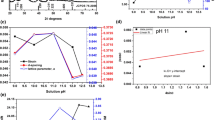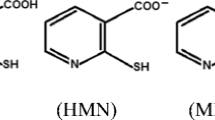Abstract
The influence of stabilizing agents and reaction time on the luminescent properties of water-soluble CdTe quantum dots (QDs) was discussed. The thioglycolic acid (TGA)-CdTe ODs were characterized by TEM, XRD and FTIR. It is found that larger-size QDs can be synthesized more easily when L-cysteine (Cys) or golutathione (GSH) is chosen as stabilizing agent and TGA is proper to prepare highly luminescent QDs because of the effect between Cd2+ and sulfhydryl group. Furthermore, the absorption wavelength, full width at half maximum (FWHM), stokes shift, photoluminescence (PL) quantum yield and PL stability of TGA-CdTe are strongly dependent on reaction time, in which the absorption wavelength changes against reaction time with an exponential function. The TGA-CdTe QDs prepared at 2 h possess more excellent luminescent properties.
Similar content being viewed by others
References
CHEN Liang-dong, LIU Jia, YU Xue-feng, HE Man, PEI Xiao-feng, TANG Zhao-you, WANG Qu-quan, PANG Dai-wen, LI Yan. The biocompatibility of quantum dot probes used for the targeted imaging of hepatocellular carcinoma metastasis [J]. Biomaterials, 2008, 29(31): 4170–4176.
GAO X H, CUI Y Y, LEVENSON R M, CHUNG L W K, NIE S M. In vivo cancer targeting and imaging with semiconductor quantum dots [J]. Nat Biotechnol, 2004, 22(8): 969–976.
CAI W B, SHIN D W, CHEN K, GHEYSENS O, CAO Q Z, WANG S X, GAMBHIR S S, CHEN X Y. Peptide-labeled near-infrared quantum dots for imaging tumor vasculature in living subjects [J]. Nano Lett, 2006, 6(4): 669–676.
YU W W, QU L H, GUO W Z, PENG X G. Experimental determination of the extinction coefficient of CdTe, CdSe, and CdS nanocrystals [J]. Chem Mater, 2003, 15(14): 2854–2860.
LIU Y S, SUN Y H, VERNIER P T, LIANG C H, CHONG S Y C, GUNDERSEN M A. pH-sensitive photoluminescence of CdSe/ZnSe/ZnS quantum dots in human ovarian cancer cells [J]. J Phys Chem C, 2007, 111(7): 2872–2878.
KAPITONOV A M, STUPAK A P, GAPONENKO S V, PETROV E P, ROGACH A L, EUCHMÜLIER A. Luminescence properties of thiol-stabilized CdTe nanocrystals [J]. J Phys Chem B, 1999, 103(46): 10109–10113.
LIU Y F, CHEN W, JOLY A G, WANG Y Q, POPE C, ZHANG Y B, BOVIN J O, SHERWOOD P. Comparison of water-soluble CdTe nanoparticles synthesized in air and in nitrogen [J]. J Phys Chem B, 2006, 110(34): 16992–17000.
TALAPIN D V, ROGACH A L, SHEVCHENKO E V, KORNOWSKI A, HAASE M, WELLER H. Dynamic distribution of growth rates within the ensembles of colloidal II–VI and III–V semiconductor nanocrystals as a factor governing their photoluminescence efficiency [J]. J Am Chem Soc, 2002, 124(20): 5782–5790.
MATTOUSSI H, MAURO J M, GOLDMAN E R, ANDERSON G P, SUNDAR V C, MIKULEC F V, BAWENDI M G. Self-assembly of CdSe-ZnS quantum dot bioconjugates using an engineered recombinant protein [J]. J Am Chem Soc, 2000, 122(49): 12142–12150.
GAPONIK N, TALAPIN D V, ROGACH A L, HOPPE K, SHEVCHENKO E V, KORNOWSKI A, EYCHMÜLLER A, WELLER H. Thiol-capping of CdTe nanocrystals: An alternative to organometallic synthetic routes [J]. J Phys Chem B, 2002, 106(29): 7177–7185.
ZHANG Hao, ZHOU Zhen, YANG Bai. The influence of carboxyl groups on the photoluminescence of mercaptocarboxylic acid-stabilized CdTe nanoparticles [J]. J Phys Chem B, 2003, 107(1): 8–13.
TALAPIN D V, HAUBOLD S, ROGACH A L, KORNOWSKI A, HAASE M, WELLER H. A novel organometallic synthesis of highly luminescent CdTe nanocrystals [J]. J Phys Chem B, 2001, 105(12): 2260–2263.
ROGACH A L, KATSIKAS L, KORNOWSKI A, SU D S, EYCHMÜLLER A, WELLER H. Synthesis and characterization of thiol-stabilized CdTe nanocrystals [J]. Ber Bunsen-Ges Phys Chem, 1996, 100(11): 1772–1778.
YU W W, WANG Y A, PENG X G. Formation and stability of size-, shape-, and structure-controlled CdTe nanocrystals: Ligand effects on monomers and nanocrystals [J]. Chem Mater, 2003, 15(22): 4300–4308.
GUO Jia, YANG Wu-li, WANG Chang-chun. Systematic study of the photoluminescence dependence of thiol-capped CdTe nanocrystals on the reaction conditions [J]. J Phys Chem B, 109(37): 17467–17473.
MANDAL A, TAMAI N. Influence of acid on luminescence properties of thioglycolic acid-capped CdTe quantum dots [J]. J Phys Chem C, 2008, 112(22): 8244–8250.
WANG Q, KUO Y C, WANG Y W, SHING G, RUENGRUGLIKIT C, HUANG Q R. Luminescent properties of water-soluble denatured bovine serum albumin-coated CdTe quantum dots [J]. J Phys Chem B, 2006, 110(34): 16860–16866.
DENG Da-wei, QIN Yuan-bin, YANG Xi, YU Jun-sheng, PAN Yi. The selective synthesis of water-soluble highly luminescent CdTe nanoparticles and nanorods: The influence of the precursor Cd/Te molar ratio [J]. J Cryst Growth, 2006, 296(2): 141–149.
DAGTEPE P, CHIKAN V. Effect of Cd/Te ratio on the formation of CdTe magic-sized quantum dots during aggregation [J]. J Phys Chem A, 2008, 112(39): 9304–9311.
HE Yao, LU Hao-ting, SAI Li-man, LAI Wen-yong, FAN Qu-li, WANG Lian-hui, HUANG Wei. Microwave-assisted growth and characterization of water-dispersed CdTe/CdS core-shell nanocrystals with high photoluminescence [J]. J Phys Chem B, 2006, 110(27): 13370–13374.
WANG Fang-bin, FAN Mei-yi, LIU You-nian, WANG Jian-xiu, ZENG Dong-ming, HUANG Ke-long. Fabrication of ferrocenyl glutathione modified electrode and its application for detection of cadmium ions [J]. Journal of Central South University of Technology, 2008, 15(1): 44–48.
PAN Dao-cheng, JI Xiang-ling, An Li-jia, LU Yun-feng. Observation of nucleation and growth of CdS nanocrystals in a two-phase system [J]. Chem Mater, 2008, 20(11): 3560–3566.
GERHARDS C, DROST C S, SGOBBA V, GULEI D M. Conjugating luminescent CdTe quantum dots with biomolecules [J]. J Phys Chem B, 2008, 112(46): 14482–14491.
BORCHERT H, TALAPIN D V, GAPONIK N, MCGINLEY C, ADAM S, LOBO A, MÖLLER T, WELLER H. Relations between the photoluminescence efficiency of CdTe nanocrystals and their surface properties revealed by synchrotron XPS [J]. J Phys Chem B, 2003, 107(36): 9662–9668.
ALIVISATOS A P. Semiconductor clusters, nanocrystals, and quantum dots [J]. Science, 1996, 271(5251): 933–937.
MURRAY C B, BAWENDI M G, KAGAN C R. Synthesis and characterization of monodisperse nanocrystals and close-packed nanocrystal assemblies [J]. Annu Rev Mater Sci, 2000, 30: 545–610.
TALAPIN D V, ROGACH A L, HAASE M, WELLER H. Evolution of an ensemble of nanoparticles in a colloidal solution: Theoretical study [J]. J Phys Chem B, 2001, 105(49): 12278–12285.
PENG X G, WICKHAM J, ALIVISATOS A P. Kinetics of II–VI and III–V colloidal semiconductor nanocrystal growth: “Focusing” of size distributions [J]. J Am Chem Soc, 1998, 120(21): 5343–5344.
CONDE J P, BHATTACHARJEE A K, CHAMARRO M, LAVALLARD P, PETRIKOV V D, LIPOVSKII A A. Photoluminescence stokes shift and exciton fine structure in CdTe nanocrystals [J]. Phys Rev B, 2001, 64(11): 113303.
EFROS A L, ROSEN M, KUNO M, NIRMAL M, NORRIS D J, BAWENDI M. Band-edge exciton in quantum dots of semiconductors with a degenerate valence band: Dark and bright exciton states [J]. 1996, 54(7): 4843–4856.
MACHOL J L, WISE F W, PATEL R C, TANNER D B. Vibronic quantum beats in PbS microcrystallites [J]. Phys Rev B, 1993, 48(4): 2819–2822.
CAI W B, HSU A R, LI Z B, CHEN X Y. Are quantum dots ready for in vivo imaging in human subjects [J]. Nanoscale Res Lett, 2007, 2(6): 265–281.
Author information
Authors and Affiliations
Corresponding author
Additional information
Foundation item: Projects(10805069, 10405034) supported by the National Natural Science Foundation of China
Rights and permissions
About this article
Cite this article
Li, Z., Wang, Yx., Zhang, Gx. et al. Luminescent properties dependence of water-soluble CdTe quantum dots on stabilizing agents and reaction time. J. Cent. South Univ. Technol. 17, 1148–1154 (2010). https://doi.org/10.1007/s11771-010-0611-4
Received:
Accepted:
Published:
Issue Date:
DOI: https://doi.org/10.1007/s11771-010-0611-4




